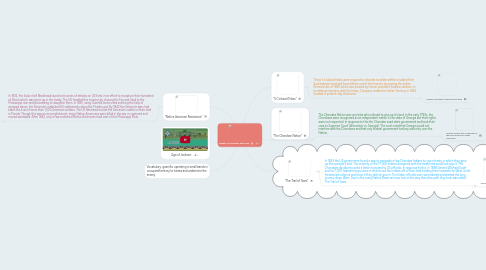Chapter 11-2:Conflicts Over Land
создатель Leila Corbin


1. "5 Civilized Tribes"
1.1. These 5 civilized tribes were required to relocate as white settlers invaded their Southeastern land and forced them out of their homes by passing the Indian Removal Act of 1830 which was backed by former president Andrew Jackson. In an attempt at peace with the tribes, Congress created an Indian Territory in 1834 located in present-day Oklahoma.
1.1.1. Osceola, the leader of the Seminole tribe
2. "The Cherokee Nation"
2.1. The Cherokee Nation was one tribe who refused to give up it's land. In the early 1790s, the Cherokees were recognized as an independent nation in the state of Georgia but their rights were not respected. In response to this the Cherokee sued state government and took their case to Supreme Court (Worcester vs. Georgia). The court ruled that Georgia could not interfere with the Cherokees and that only federal government had any authority over the Nation.
2.1.1. Andrew Jackson was a supporter of the force removal of Native Americans.
3. "The Trail of Tears"
3.1. In 1853 the US government found a way to persuade a few Cherokee Indians to sign a treaty in which they gave up their people's land. The majority of the 17,000 Indians disagreed with the treaty and would not sign it. The Cherokees decided to write a letter in protest to US officials. In response to this, in 1838 General Winfield Scott and his 7,000 federal troops came in and forced the Indians off of their land,herding them towards the West. Scott threatened violence and force if they did not give in. The Indian officials soon surrendered and started the long journey down West. Due to the many Native American lives lost on the way there,the path they took was called The Trail of Tears.
3.1.1. General Winfield Scott
4. "Native American Resistance"
4.1. In 1832, the Sauk chief Blackhawk launched a series of attacks on US forts in an effort to recapture their homeland of Illinois which was given up in the treaty. The US handled this invasion by chasing the Fox and Sauk to the Mississippi river and proceeding to slaughter them. In 1835, using Guerrilla tactics and enlisting the help of escaped slaves, the Seminole's attacked US settlements along the Florida cost. By 1842 the Seminole wars had taken the lives of more than 1,500 American soldiers. The US retreated and let the Seminole's settle on their land in Florida. Though this was an accomplishment, many Native Americans were killed in the war or captured and moved westward. After 1842, only a few scattered Native Americans lived east of the Mississippi River.
4.1.1. The chief of the Sauk Native Americans, Blackhawk.
